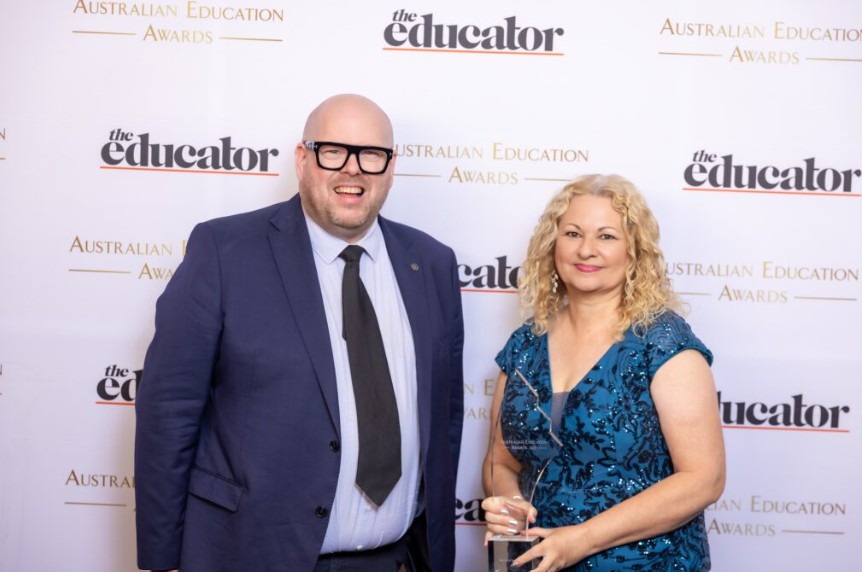
Nestled in the heart of Darwin, Larrakeyah Primary School has earned a reputation for punching well above its weight.
Serving a multicultural community of about 520 children (half of whom speak English as a second language) the school has become a regular fixture on the awards circuit in recent years.
In 2022, the school scooped the national Best STEM Program Award and, that same year, was ranked among the top three schools worldwide for its work supporting student wellbeing through the World’s Best School Prizes. In August 2025, it took home the Best Use of Technology Award at the Australian Education Awards and weeks later was named one of The Educator’s 5-Star Best Schools, further cementing its reputation as one of Australia’s most forward-thinking primary schools.
The guiding force at the helm is Principal Fathma Mauger. With almost 40 years of experience as an educator, Mauger began as a classroom teacher before rising to the role of principal in 2009. She is also an accredited Australian Council of Educational Research NT lead reviewer, which involves reviewing schools’ performance against a national teaching and learning framework.
Mauger says the school’s approach to technology is underpinned by a simple philosophy: innovation must have purpose.
“When we talk about the pillars of an effective technology program, it starts with a clear framework for implementation,” Mauger told The Educator. “Students and teachers must have reliable access to technology, supported by timely and responsive technical assistance.”
Mauger also noted the importance of a strong professional development plan so teachers can continue building their digital capability and feel confident using technology to enhance learning.
“Just as importantly, teachers require ongoing support to integrate technology with curriculum so it becomes part of everyday practice rather than an add-on,” she said.
“We must also ensure staff are equipped to use digital tools to deliver personalised learning and develop innovative teaching programs.”
Central to all of this, said Mauger, is the need to maintain a safe online environment.
“Finally, our digital systems — including AI — must enable teachers to use data effectively to inform their teaching practice. These elements together create the foundation for meaningful, future-focused learning.”
AI that lifts students’ critical thinking
A big contributing factor to the school’s recent Best Use of Technology Award is ‘IntelliLearn’ – a program designed and custom-built by teachers that engages students through oral and written language, asks questions, provides prompts, and gives feedback to support continuous improvement.
Unlike ChatGPT, the tool operates within controlled parameters of the curriculum, offering prompts and feedback like a teacher.
Data shows remarkable growth, with 92% of Year 5 students and 100% of Year 6 students meeting or exceeding literacy benchmarks, comparing pretest and post-test writing data. The school’s NAPLAN data also shows an upward trend in writing proficiencies.
“This inspiring initiative challenges the status quo by transforming how students engage with writing, without replacing teachers or providing answers,” Mauger said, adding that IntelliLearn delivers highly individualized, scaffolded support, adapting in real time to each learner’s needs.
“Teachers observed students’ improved confidence in Writing, on-task behaviours and significantly improved writing skills and writing quality, particularly from EAL/D students.”
Quality teaching leads the way, tech follows
Mauger said the school’s carefully thought-out technology framework has allowed it to strike the right balance so that technology improves learning outcomes.
“Our school ensures that there is a strong focus on quality teaching and learning and consistency in pedagogy across the school,” she said. “This is the foundation, and technology is leveraged to support this.”
Mauger said digital innovation is woven through the curriculum to lift student learning, supported by clear pedagogical frameworks that guide how teachers meaningfully incorporate technology to enhance classroom practice.
“An explicit professional learning plan for staff ensures that teachers are able to use digital tools and understand the integration with curriculum. Teachers plan in teaching teams and implement digital tools in teaching programs to improve content and lesson delivery,” she said.
“Technology is not an ‘add-on’ or an isolated lesson but is implemented seamlessly into the curriculum to improve student learning outcomes.”
When asked what she believes are the key technological competencies and mindsets that every student and teacher will need to thrive in the decade ahead, Mauger pointed to embracing innovation, having a growth mindset and thinking outside the box.
“Teachers and students need to focus on the skills that students will need in any future job – communication, collaboration, creativity and critical thinking,” she said.
“Teachers need to be prepared to change their teaching, understand how our student ‘digital natives’ are learning, skilfully incorporate digital tools and use technology to support quality teaching and learning across the curriculum.”

